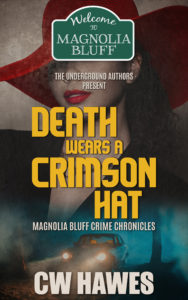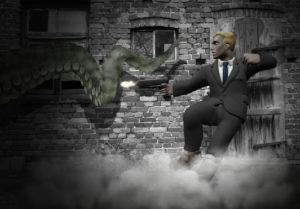Once again I’m taking a stroll down the streets of Magnolia Bluff, Texas.
I say hello to those I meet on my morning walk. There’s Gunter Fight entering his bank. We exchange waves.
I pass by the bakery, mostly because my waistline says I should, but I do wave to Noonan Leigh, the owner. He’s busy so I don’t know if he saw me or not. Best pastries, cakes, and doughnuts in town at Bluff Bakery. At least so I hear.
Down by the courthouse I run into Reece Sovern. He’s the police investigator in Magnolia Bluff. And rather than my words to tell you about Reece, I’m going to once again let Caleb Pirtle talk to you and fill you in on Magnolia Bluff’s detective.
You can find the original blogpost here.
Down deep inside, Detective Reece Sovern may be the happiest man in town. He has a murder to investigate. He’s in the big-time now.
Reece Sovern has been a policeman all of his life.
Spent years driving a patrol car.
Kept his nose clean.
Worked his way up the chain of command.
And now he’s a detective in the small town of Magnolia Bluff.
Mostly he investigates the small stuff.
Thefts.
Burglaries.
Peeping Toms.
But in Death Wears a Crimson Hat, Book 1 of the Magnolia Bluff Crime Chronicles, Reece Sovern finds himself with a murder and a hit-and-run.
Maybe the hit-and-run was an attempted murder.
He’ll find out.
Down deep inside, Reece Sovern may be the happiest man in town.
He’s in the big-time now.
He’ll begin his investigation by talking to the biggest and probably the richest flirt in Magnolia Bluff.
*
Standing on the sidewalk, Reece Sovern unwrapped a cigar, stuck it in his mouth, and walked back to the city hall and police complex to get his car. He’d start by talking to Scarlett Hayden.
Sovern drove around the north end of Burnet Reservoir to Hayden’s Resort, which was situated on the northwest shore of the reservoir.
He remembered when the Haydens bought the fifty acres, put in twenty cabins, and then added a campground with twenty spots. They’d built a fabulous Prairie-style home for themselves, as well.
After all these years, the whole shebang must be worth a few millions, the detective thought, as he pulled into the drive, which was marked private. He wound his way through bald cypress, pecan, Texas ash, cottonwood, bur oak, and cedar elm. He emerged in a clearing. He recognized Scarlett’s big Land Rover and speculated that the beat up Honda parked next to it belonged to some young guy from the college. If one were to believe the gossip, that is.
Of course, if one did believe the gossip, Scarlett Hayden would rarely, if ever, be vertical. And he’d just seen her a little while ago in a vertical position. Besides, she had a resort to run, even though the Smiths did much of the day to day management, Scarlett still had to watch the big picture, which probably meant she was vertical quite a bit of the time.
He parked his car, got out, and walked up to the door. A vision flashed before his eyes of Scarlett walking into Thurgood’s coffee shop. He shook his head and pressed the doorbell.
After what seemed forever, the door opened.
“Mr. Sovern. What a pleasant surprise. What can I do for you?”
She was wearing one of those filmy white outfits that women wore in the movies from the 1930s. Jesus, he said to himself. Out loud he said, “I’d like to ask you a few questions.”
“Sure. C’mon in.” She stepped away from the door and headed for somewhere in the house.
He entered, closed the door, and followed. Her outfit billowed behind her like a cumulus cloud until she stopped at a door.
“We can talk in here.” Her hand motioned for Sovern to enter the room, which he did.
Scarlett followed and sat on the sofa, then tucked her legs under her.
Sovern sat, met her gaze, swallowed, pushed his glasses up his nose, and asked, “What happens if Mary Lou dies? With the society, that is?”
“We elect a new queen. And we’ll add a couple new members.”
“What does the society actually do?”
Scarlett chuckled. “It doesn’t do anything, Mr. Sovern. We girls just wanna have fun. So, we have fun.”
“I find it difficult to picture Mary Lou Fight having fun.”
Scarlett laughed loudly. “Then you don’t know Mary Lou. She has the most fun of us all. All of her gossipy little doings. She damn well has everyone in fear of her. What will she tell? What will she not? And at what price?”
“And you? Does she have you in the palm of her hand?”
“Good lord, no. But that’s only because I don’t give a damn.”
“So who do you think would want Louisa Middlebrook and Mary Lou Fight dead?”
“Louisa?” Sovern watched her cock her head and aim her eyes at the ceiling, and hold that pose for a moment, before turning those dark orbs of hers back to him. “I don’t have a clue. Most likely someone she pissed off when she became Mary Lou’s lap dog.”
“Lap dog?”
“Oh, yes. Mary Lou gave Louisa social standing. Made her somebody. And for that honor, she practically worshipped Mary Lou.”
Sovern thought on that for a moment, and then said, “And Mrs. Fight?”
Once again, Scarlett’s throaty laugh filled the room. “You’d be better off asking, Reece…”
The investigator couldn’t help but notice how she drew out his name and that her eyes became filled with longing. He cleared his throat.
“You’d be better off asking who didn’t want to kill her.”
“And who might that be?”
“I’d guess her husband, Harry Thurgood, and myself, of course. Actually, I have second thoughts about her husband.”
“Why do you exempt Thurgood and yourself?”
“Because neither one of us gives a damn about this little pimple on the butt of nowhere.”
*
Please click HERE to find Death Wears A Crimson Hat on Amazon.
Sandy Signing In wrote on Amazon:
Death Wears A Crimson Hat is a well-written mystery. It’s filled with characters, especially members of the Hats, who are deeply flawed and very believable. Mary Lou’s unprincipled character is one that evokes both dread and disgust. So, I’d have to say that the author, CW Hawes, definitely elicited an emotional response in this reader. Hawes also used character personalities, dialog and action in a way that kept me completely engaged throughout the book. Great job, Mr. Hawes! This is a story that I can highly recommend.
You can’t beat that for a hearty recommendation. Thank you Sandy Signing In!
Comments are always welcome. And until next time, happy reading!
 CW Hawes is a playwright, award-winning poet, and a fictioneer, with a bestselling novel. He’s also an armchair philosopher, political theorist, social commentator, and traveler. He loves a good cup of tea and agrees that everything’s better with pizza.
CW Hawes is a playwright, award-winning poet, and a fictioneer, with a bestselling novel. He’s also an armchair philosopher, political theorist, social commentator, and traveler. He loves a good cup of tea and agrees that everything’s better with pizza.
If you enjoyed this post, please consider buying me a cup of tea. Thanks! PayPal.me/CWHawes
Share This!

